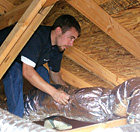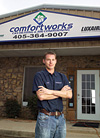
Chris Gilley, a technician at Comfortworks, works on the ductwork for one of the homes in the Hope Crossing installation.
The community of Hope Crossing, about 250 blue collar homes, is 10 miles northeast of Oklahoma City. It is a Habitat for Humanity development that contractor Chris Ellis, 30-year-old president of Oklahoma City-based Comfortworks Inc., has spent considerable time and resources in an effort to help incoming residents control utility costs.
Habitat for Humanity strives to provide affordable housing, but regulating utility costs in the homes isn’t a controllable option. Oklahoma City is considered a mixed-humid climate requiring significant amounts of both heating and cooling, and combating substantial humidity levels throughout the year. Air conditioning is a must in all new homes, which makes air-based distribution systems the norm. Most new homes use either a central forced-air gas furnace coupled with a split-system air conditioner, or a split-system central air-source heat pump and supplemental resistance heat.
In low-cost, single-story houses, typical of the Hope Crossing homes, a standard duct system is used for heating and cooling. While easy to install, they are often not the best choice for energy efficiency. In response, ClimateMaster made it possible for Habitat for Humanity to offer incoming Hope Crossing residents energy-efficient homes by donating high-tech geothermal heating and cooling systems to all the homes in the development.
SAVING ENERGY
The Hope Crossing homes have integrated ground-loop pumping and purging valves in the heat pump to save on required space, equipment cost, and field labor content. Additionally, a single 400 foot geothermal loop is located directly under the floor slab instead of the typical practice of drilling two 200 foot heat exchangers 20 feet apart in the lawn, which requires a separate excavation step to manifold them and route the piping into the house. Comfortworks has typically been installing a 2-ton ClimateMaster Tranquility 27 water-to-air geothermal system, fully ducted, wired and ready to go in the Hope Crossing homes. The 2- through 6-ton Tranquility 27 line uses EarthPure® (HFC-410A) zero ozone depletion refrigerant. The systems offer efficiencies up to 31.5 EER and 5.1 COP.“We have been involved with this project for about two years,” said Ellis. “We’re involved with Habitat because it’s the right thing to do.”

Chris
Gilley (left), technician, and Chris Ellis, Comfortworks, complete a geothermal
installation at the all-geo Hope Crossing development.
According to ClimateMaster, the 217 low energy geothermal homes constructed in the Hope Crossing project will collect-ively save nearly 1,100 metric tons of CO2 per year, or 22,000 metric tons over a nominal 20-year lifespan, compared to the standard gas homes that Central Oklahoma’s Habitat for Humanity (COHFH) had been building.
Habitat CEO Jonathan Reckford said while Habitat homes across the board are becoming more energy-efficient, Hope Crossing holds a special distinction. “Hope Crossing is the largest green-build Habitat community in the United States,” he said. “That’s something that is setting the tone and path for the rest of the country as well.”

Chris
Ellis, 30-year-old president of Oklahoma City-based Comfortworks Inc., began as
a technician and moved on to owning his own business through
acquisition.
CONTRACTOR'S FUTURE
The Hope Crossing geothermal heat pump project isn’t an anomaly for Comfortworks. As one of the largest geothermal systems installers in the state of Oklahoma, the once more traditional HVAC company now focuses strongly on geothermal and Ellis has expanded the business to include radiant floor heating, pool heating, and domestic hot water.“Almost all of our commercial and residential work involves geothermal in some fashion,” said Ellis. “There’s a great future for those in geothermal business. We plan to grow steadily and at a pace that can be sustained.”
The company’s billings stem from a mix of varied residential new construction work, including 60 percent geothermal, 30 percent commercial HVAC with solid geothermal and water-to-water involvement, and 10 percent residential retrofit entirely devoted to geothermal.
“The biggest measure of our success won’t be annual sales volume, new acquisitions, territory growth or profit margin. Number one on that list is customer satisfaction. We’ll measure it steadily. If it drops, we apply the brakes and make adjustments. This will be behind every move we make.”
According to Ellis, geothermal systems promise tremendous savings to the customer over the long term as compared to traditional sources of energy such as oil, electric resistance, natural gas, or propane.
“With geo, annual heating bills drop by 50 to 80 percent, depending on the system that is replaced,” said Ellis. “Simply, I tell customers that a geothermal installation pays you to own it. Geothermal energy is not subject to rising costs or unpredictable price swings.”
In addition to the cost and carbon footprint advantages, Ellis pointed out that there are other key benefits. The first that he stressed was comfort. In homeowner surveys, geothermal systems are routinely ranked as “more comfortable” than traditional systems and they also offer comfort without abrupt temperature and humidity changes.
Another benefit Ellis pointed out is low cost hot water. A geothermal system will heat water two to three times more efficiently than a regular hot water tank.
“There isn’t any equipment noise or exposure, and it’s environmentally responsible,” said Ellis. “Geothermal systems are totally non-polluting. In fact, installing a geothermal system to replace a fossil fuel system immediately cuts the personal emissions contribution by 50 percent, or the equivalent of taking several cars off the road.”
According to Ellis, in certain regions, replacing an electric resistance system in the home with geothermal can drop the structure’s indirect emissions load by a substantial amount.
“The whole experience - business ownership, working with a great bunch of professionals, strong customer relationships, and growth of the geothermal work I chose for a career - has been a dream come true,” concluded Ellis. “It’s very exciting, and the way the market’s moving, it’ll be swinging in our direction for a long time.”
Publication date:05/23/2011

Report Abusive Comment